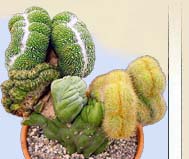Indoor
Floriculture

Leafy succulents
by Peter Lapshin

Cacti Library
'Cultivar' (V.Kalishev)

Moscow
Succulent Society

Moscow Indoor
Plant Club

Travels, nature,
botanical gardens

About Episcia
(Gesneriaceae)
 |
 |
CULTIVAR / КУЛЬТИВАР e-Magazine about exotic forms of Cactaceae ENGLISH / RUS-(Win1251) | |||
|
|
|

|
Melon cacti Georgy Volsky
First Europeans came in the middle of the XVI century in the unknown land of the American continent and the islands of West Indies, among other wonders of the New World had been much surprised spherical prickly plants with colorful woolly hat on top. Overseas gimmick brought to Europe. Their bizarre silhouettes appeared in medieval books about plants. Melons cacti (outside the body), or the Turkish cap (with the fancy jewelry) - the so-called unusual steel plant. These were Melocactus - one of the first messengers of the enchanting world of cactuses, which met the inhabitants of the Old World. Not surprisingly, the first around the travelers - the sailors of Columbus expedition - is met with these plants. In fact, most species of Melocactus, and they are now known for over forty, are growing at the edge of the Earth, on the shores of the Pacific and Atlantic oceans. Homeland melon cacti - Cuba, Haiti, Trinidad, Tobago, Curacao and other islands of the vast archipelago of the West Indies and the coastal areas of Central America, Brazil, Colombia, Venezuela, northern Peru. On the barren shore sands, near the border surf washed by salty sea spray, live Melocactus. flat spherical cacti in diameter from 10 to 30 centimeters are 10-15 ribs. At the areola sit radial and central prickles of various shades of yellow and brown colors. Many types of central prickles up to 3-5 cm in length, often whimsically bent. Usually the central thorn is longer, stronger and more brightly colored than the radial, but they are smaller. However, no color and location of thorns, not the size and shape of these remarkable cacti. They have their famous woolly hat that appears at the top of the plant for the fifth-sixth year of life. The scientific name of this interesting educational - cephaly, from the Greek word kefalus - head. Cephaly of Melokaktus is a cylindrical shaped felt growth in diameter and 10 centimeters. Young plants, it is quite flat, but increases with age, sometimes reaching 10-15 cm in height, it is branched (photo 1). Woolly hat littered with many thorns, painted in very bright brownish red color. This painting cephaly and trim makes this a rather modest cactus. Perhaps it serves to attract insect pollinators, but the precise designation of its still unknown botany. When cephaly well enough will develop, at its apex is formed many small, about 2 centimeters, the flowers are more pink-reddish. Blossoming Melokaktus look extraordinarily beautiful - in fact none other types of cacti do not have such a remarkable double decorations - woolly hats and flowers (photo 2). However, many also have Cereus cephaly, but it is not so beautiful and not so brightly colored. various insects pollinate the flowers, and fruit Melokaktus fastened. They ripen until the next year, and yet not see them: they are hidden inside cephaly. Ripe red berries look elongated club-shaped form of the "wool" cephaly. If they break - inside juicy flesh visible brownish-black seeds. Melokaktus rarely provide lateral shoots - kids, but good breeding seeds. Yearling seedlings with care care grow up to 1,5-2 cm. As young seedlings, and adult plants Melokaktus like loose sandy ground, with the addition of a small quantity of broken bricks, lime and peat. Very good admix to the ground mixture of purified sea sand. Adequate abundant moisture, regular spraying, warm and slightly pritenennoe sun - necessary conditions for the successful year the content of these interesting plants. Wintering Melokaktus must be dry and cool, but not less than 8-10 degrees. It should be treated with caution for the transitional period - in spring and autumn, when the greatest danger of pouring or peresushit Melokaktus. For the novice fan to grow these cacti difficult.
|
| Cultivar e-magazin: Copyright (c) by Valery Kalishev, Chelyabinsk, Russia, since 2000. Design and hosting by Peter Lapshin, since 2002. Contacts: Peter Lapshin |
|
|